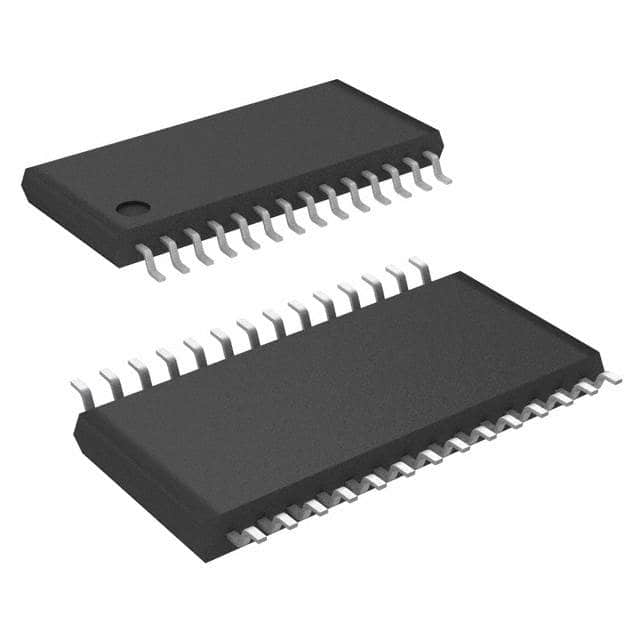Viz Specifikace pro podrobnosti o produktu.

AD7708BRU-REEL
Product Overview
Category
The AD7708BRU-REEL belongs to the category of Analog-to-Digital Converters (ADCs).
Use
This product is primarily used for converting analog signals into digital data. It is commonly employed in various applications that require precise and accurate conversion of analog signals, such as sensor interfaces, industrial automation, and data acquisition systems.
Characteristics
- High-resolution: The AD7708BRU-REEL offers a high resolution of up to 16 bits, ensuring accurate conversion of analog signals.
- Low power consumption: This ADC operates at low power levels, making it suitable for battery-powered devices and energy-efficient applications.
- Versatile input range: It supports both single-ended and differential input configurations, providing flexibility in signal acquisition.
- On-chip filtering: The device incorporates programmable filters to eliminate noise and enhance signal quality.
- Serial interface: The ADC utilizes a serial interface (SPI) for communication with microcontrollers or other digital devices.
Package and Quantity
The AD7708BRU-REEL is available in a small outline integrated circuit (SOIC) package. It is typically supplied in reels containing a specific quantity of units, which may vary depending on the supplier or manufacturer.
Specifications
- Resolution: Up to 16 bits
- Input Channels: 8
- Input Range: Programmable, ±Vref
- Conversion Rate: Up to 250 kSPS (samples per second)
- Supply Voltage: 2.7 V to 5.25 V
- Operating Temperature Range: -40°C to +105°C
Pin Configuration
The AD7708BRU-REEL features a 28-pin SOIC package with the following pin configuration:
- AIN1(+) - Analog Input Channel 1 Positive Terminal
- AIN1(-) - Analog Input Channel 1 Negative Terminal
- AIN2(+) - Analog Input Channel 2 Positive Terminal
- AIN2(-) - Analog Input Channel 2 Negative Terminal
- AIN3(+) - Analog Input Channel 3 Positive Terminal
- AIN3(-) - Analog Input Channel 3 Negative Terminal
- AIN4(+) - Analog Input Channel 4 Positive Terminal
- AIN4(-) - Analog Input Channel 4 Negative Terminal
- AIN5(+) - Analog Input Channel 5 Positive Terminal
- AIN5(-) - Analog Input Channel 5 Negative Terminal
- AIN6(+) - Analog Input Channel 6 Positive Terminal
- AIN6(-) - Analog Input Channel 6 Negative Terminal
- AIN7(+) - Analog Input Channel 7 Positive Terminal
- AIN7(-) - Analog Input Channel 7 Negative Terminal
- AIN8(+) - Analog Input Channel 8 Positive Terminal
- AIN8(-) - Analog Input Channel 8 Negative Terminal
- VREF(+) - Reference Voltage Positive Terminal
- VREF(-) - Reference Voltage Negative Terminal
- DVDD - Digital Supply Voltage
- DGND - Digital Ground
- CS - Chip Select
- SCLK - Serial Clock
- DIN - Data Input
- DOUT - Data Output
- DRDY - Data Ready
- RESET - Reset Input
- AVDD - Analog Supply Voltage
- AGND - Analog Ground
Functional Features
- Programmable Gain Amplifier (PGA): The AD7708BRU-REEL incorporates a PGA that allows amplification of the input signal to improve resolution and accuracy.
- On-Chip Temperature Sensor: It includes an on-chip temperature sensor for monitoring the device's operating temperature.
- Digital Filters: The ADC features programmable digital filters to remove noise and enhance signal quality.
- Daisy-Chain Mode: Multiple AD7708BRU-REEL devices can be connected in a daisy-chain configuration, simplifying the interface with microcontrollers.
Advantages and Disadvantages
Advantages
- High resolution ensures accurate conversion of analog signals.
- Low power consumption makes it suitable for energy-efficient applications.
- Versatile input range provides flexibility in signal acquisition.
- On-chip filtering improves signal quality.
- Serial interface simplifies communication with digital devices.
Disadvantages
- Limited number of input channels (8 channels).
- Requires external voltage reference for optimal performance.
Working Principles
The AD7708BRU-REEL operates based on the successive approximation register (SAR) architecture. It samples the analog input voltage and converts it into a digital representation using an internal SAR algorithm. The converted digital data is then made available through the serial interface for further processing or storage.
Application Field Plans
The AD7708BRU
Seznam 10 běžných otázek a odpovědí souvisejících s aplikací AD7708BRU-REEL v technických řešeních
Sure! Here are 10 common questions and answers related to the application of AD7708BRU-REEL in technical solutions:
Q: What is the AD7708BRU-REEL? A: The AD7708BRU-REEL is a high-resolution, low-power analog-to-digital converter (ADC) designed for precision measurement applications.
Q: What is the resolution of the AD7708BRU-REEL? A: The AD7708BRU-REEL has a resolution of 16 bits, allowing for precise measurement of analog signals.
Q: What is the input voltage range of the AD7708BRU-REEL? A: The AD7708BRU-REEL supports bipolar input voltage ranges from -Vref to +Vref, where Vref is the reference voltage supplied to the ADC.
Q: Can the AD7708BRU-REEL be used with different types of sensors? A: Yes, the AD7708BRU-REEL can be used with various types of sensors such as temperature sensors, pressure sensors, strain gauges, etc., as long as they provide an analog output.
Q: How many channels does the AD7708BRU-REEL support? A: The AD7708BRU-REEL supports up to 8 differential or 16 single-ended input channels, providing flexibility in multi-channel measurement applications.
Q: What is the maximum sampling rate of the AD7708BRU-REEL? A: The AD7708BRU-REEL can achieve a maximum sampling rate of 19.2 kSPS (thousand samples per second), allowing for real-time measurements.
Q: Does the AD7708BRU-REEL require an external reference voltage? A: Yes, the AD7708BRU-REEL requires an external reference voltage to set the measurement range. This reference voltage should be stable and accurate.
Q: Can the AD7708BRU-REEL operate in a low-power mode? A: Yes, the AD7708BRU-REEL has a low-power mode that reduces power consumption when not actively sampling, making it suitable for battery-powered applications.
Q: What is the interface used to communicate with the AD7708BRU-REEL? A: The AD7708BRU-REEL uses a serial peripheral interface (SPI) for communication with a microcontroller or other digital devices.
Q: Are there any evaluation boards or development kits available for the AD7708BRU-REEL? A: Yes, Analog Devices provides evaluation boards and software tools to help developers quickly prototype and evaluate the AD7708BRU-REEL in their applications.
Please note that these answers are general and may vary depending on specific application requirements.

